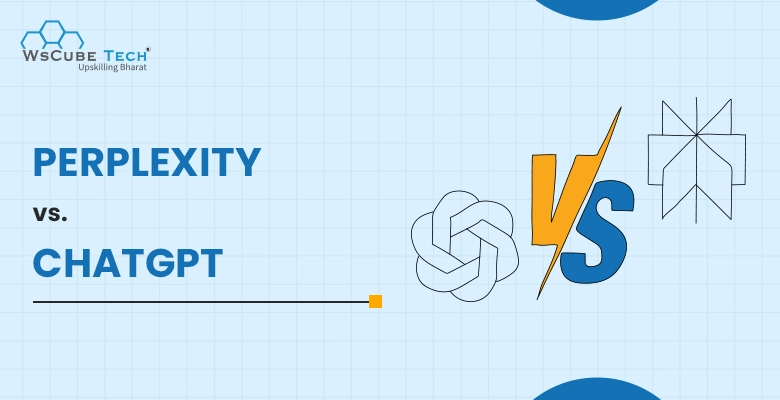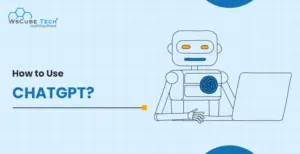Let’s be honest, we’re all swimming in information these days, and finding the right AI tool is like picking the perfect coffee: strong, reliable, and suited to your taste. If you’ve been wondering whether Perplexity AI or ChatGPT is the better choice for your needs, you're not alone.
Both tools have gained immense popularity, but for different reasons. One is like a high-speed research assistant (Perplexity AI), while the other feels like having a super-creative co-worker who never sleeps (ChatGPT). So, how do you choose between them?
Let’s break down ChatGPT vs Perplexity AI, starting with what each tool actually is, how it works, and where it shines.
What is Perplexity AI?
Perplexity AI is essentially a conversational search engine powered by artificial intelligence. Unlike Google, which gives you a list of links, Perplexity actually reads the web and delivers summarized, up-to-date answers, complete with citations. It's built on top of advanced language models, such as GPT-4 and Claude, and focuses heavily on information accuracy and clarity.
Imagine asking a question and receiving a concise, accurate answer sourced from trustworthy sources, without ever needing to click a single link. That’s the magic of Perplexity.
Key Features of Perplexity AI
Real-Time Internet Access: Fetches current data from the web, making it ideal for news, trends, or rapidly changing topics.
Citation-Based Responses: Every answer includes clickable references from trusted websites like Wikipedia, TechCrunch, PubMed, and more.
Co-Pilot Mode: Offers interactive deep-dive experiences where the AI guides your research with follow-up suggestions.
Contextual Chat Threading: Keeps track of your previous questions, allowing for a full conversation, not just isolated queries.
Search by Topic: Enter a broad keyword, and Perplexity breaks it down into focused questions to explore.
No Account Needed (for basics): You can use it instantly without any login barrier, though signing up unlocks more features.

Pros of Perplexity AI
- Highly accurate and up-to-date answers thanks to real-time web access
- Built-in transparency with linked citations, which is excellent for researchers, students, and fact-checkers
- Minimalist, fast-loading interface that keeps distractions to a minimum
- Great for specific, factual, or academic queries
- Free version is genuinely useful, even without creating an account
- Excellent source discovery, so you can often find resources you didn’t know existed
Cons of Perplexity AI
- Weak creative capabilities, so don’t expect it to write poetry, blogs, or scripts with flair
- Limited customization doesn’t allow you to create specialized AI personas or workflows
- Occasionally, too brief, so summaries can feel overly concise or lacking depth
- UI lacks personality, which means it is functional but not fun; some may find it too sterile
- Pro plan required for model switching and in-depth tasks
What is ChatGPT?
ChatGPT is OpenAI’s conversational AI chatbot that’s built on the GPT (Generative Pre-trained Transformer) models. While it initially gained fame for writing essays and helping with homework, it has since evolved into a full-blown AI assistant for everything, from ideation and planning to coding, summarizing, and even image creation.
With the GPT-4o upgrade, ChatGPT has become even faster, smarter, and more multimodal (meaning it can handle text, images, and voice). Think of ChatGPT as your virtual co-pilot for almost anything.
Key Features of ChatGPT
Natural, Conversational AI: Can respond in human-like ways, understand tone, and maintain long-form discussions.
Creative Content Generation: Easily writes blogs, poems, stories, social media captions, and more.
Coding and Debugging Help: Generates scripts, explains code, and even fixes bugs in real time.
Image Generation (GPT-4o): Create AI-generated images using natural language prompts.
Memory (for Plus users): ChatGPT can remember facts you’ve shared to offer personalized assistance.
Custom GPTs: Build or explore specialized chatbots for niche tasks like legal help, SEO audits, or cooking ideas.
Tool Access (Plus only): Includes DALL·E, browser tools, and code interpreter.
Pros of ChatGPT
- Extremely versatile; handles creative, technical, and conversational tasks with ease
- Engaging and human-like tone, it’s like chatting with a very helpful friend
- Great for brainstorming and content ideation, especially in writing, marketing, or education
- Wide ecosystem with plugins and GPTs to expand functionality
- Powerful for developers and tech-savvy users, and can write and optimize code in multiple languages
- Easy to customize, especially with GPTs that align with your personal or professional needs
Cons of ChatGPT
- Free version lacks real-time knowledge; GPT-3.5 doesn't browse the web, so it's not great for current events
- Sometimes “hallucinates” facts, especially when asked about niche or highly technical topics
- Citation support is limited unless you're using web browsing or plugins
- Paid version required ($20/month) to access the best tools and models
- May generate verbose or fluffy content without tight prompting
Also read: What is ChatGPT? Uses, Key Features, and More
Perplexity AI vs ChatGPT: Detailed Comparison
Perplexity is great for finding real-time, fact-based information, while ChatGPT is better for creative tasks and boosting productivity. To help you choose the right one, let’s compare them based on their language models, features, uses, pricing, and more.
1. Language Models and Intelligence
Perplexity AI uses a mix of large language models, including GPT-4, Claude by Anthropic, and Mistral. It dynamically selects the best model depending on your query (available for Pro users). Its strength lies in factual accuracy, as it relies on real-time web search to inform responses. However, it's more analytical than imaginative, perfect for reliable answers but not as strong in storytelling or voice customization.
ChatGPT is based on OpenAI’s proprietary GPT models, GPT-3.5 for free users and GPT-4o for Plus subscribers. GPT-4o is multimodal, faster, and more capable of nuanced reasoning, creative writing, and personality adaptation. It can maintain longer, contextual conversations and produce more fluid, natural output. So, while Perplexity focuses on precision and citations, ChatGPT focuses on breadth, depth, and conversational quality.
2. Integration and API Access
Perplexity currently doesn’t offer a full-fledged public API for custom integrations like ChatGPT does. It’s more of a standalone app or web-based assistant. While some enterprise plans may include integration features, the tool is primarily designed for users who want fast research capabilities with minimal setup, ideal for researchers, students, and professionals seeking straightforward answers.
ChatGPT shines in integration. OpenAI provides a robust API that developers can use to build custom apps, bots, assistants, or even integrate AI directly into products. Through platforms like Zapier, Slack, or Notion AI, ChatGPT’s capabilities can be woven into larger digital ecosystems. Its plugin ecosystem and ability to create custom GPTs also make it highly adaptable for business, marketing, or technical teams. If API integration is a major need, ChatGPT is clearly ahead.
3. Modes and Interaction Styles
ChatGPT offers multiple interaction modes for different tasks: code interpreter (a.k.a. advanced data analysis), web browsing, image generation, and file analysis (PDFs, spreadsheets, etc.). With GPT-4o, it can now even understand images, and users can speak to it through voice for a more natural interaction. Its conversational memory helps tailor responses over time, especially in longer engagements.
Perplexity is much simpler in this regard. It’s mostly focused on text-based Q&A with real-time web capabilities. There’s no image generation, coding environment, or document upload functionality as you’d find in ChatGPT. However, its “CoPilot” mode does simulate a smart assistant-like interaction where it guides you through follow-up questions. This makes it excellent for research-based dialogues, but limited when it comes to rich, multimodal experiences.
4. Use Cases and Ideal Users
Perplexity is ideal for researchers, journalists, students, and professionals who need fast, accurate answers backed by sources. If your goal is to get up-to-date factual information, whether it’s health data, current events, or academic references, Perplexity excels. It’s especially helpful in professional environments where citation and source credibility matter more than tone or flair.
ChatGPT, in contrast, is a true generalist. It can serve writers, marketers, educators, programmers, and even casual users equally well. It’s excellent for brainstorming blog ideas, writing stories, explaining complex topics, debugging code, or just chatting. While it’s not as source-focused as Perplexity, its ability to be witty, empathetic, and adaptable makes it a strong AI companion for creative and productivity-driven tasks.
5. Pricing and Accessibility
Perplexity AI is surprisingly generous in its free tier; you can use real-time search, ask questions, and get citations without even logging in. The Pro plan is priced at $20/month, unlocking advanced features like model switching (choose between GPT-4, Claude, etc.), longer context windows, and improved CoPilot performance. There’s also a $200/year plan for long-term users. It's a solid deal for knowledge workers.
ChatGPT’s free version uses GPT-3.5 and doesn’t include browsing or tools. To unlock GPT-4o and advanced tools (like code interpreter, image creation, and memory), you’ll need the ChatGPT Plus plan for $20/month. Unlike Perplexity, it requires an OpenAI account even to get started. While the cost is the same, ChatGPT arguably offers more depth and versatility for users who need multiple tools in one place.

6. Accuracy and Reliability
Perplexity has a clear edge in factual reliability, especially since it draws answers directly from live web sources. The tool is transparent about where information comes from and cites everything, even linking to multiple perspectives when needed. It avoids hallucination better than many chatbots because of this grounded design, making it especially valuable in research-heavy fields.
ChatGPT, even in GPT-4o mode, still struggles with occasional hallucinations, confidently stating incorrect facts if it doesn’t know the answer or when offline browsing is used. However, it compensates with fluid dialogue, reasoning, and the ability to rephrase or clarify answers. When it’s connected to the web (via plugins or browser mode), accuracy improves, but it's still less citation-focused than Perplexity.
Also read: 9 Best AI Writing Tools
Perplexity AI vs ChatGPT AI: Key Differences
| Parameter | Perplexity AI | ChatGPT |
| Language Models | Uses multiple LLMs: GPT-4, Claude, Mistral (Pro users can choose) | GPT-3.5 (Free) and GPT-4o (Plus) developed by OpenAI |
| Real-Time Web Access | Yes, by default—fetches current data with citations | Yes (Only with Plus plan and browsing tool enabled) |
| Citation Support | Strong—every answer includes clickable sources | Limited—citations only with browsing; not always present |
| Best For | Research, factual Q&A, academic and professional use | Creative writing, brainstorming, coding, general conversation |
| Custom GPTs/Plugins | Not available | Yes—Plus users can build/use Custom GPTs and plugins |
| Image Generation | No | Yes (Plus) – DALL·E-powered image generation |
| Voice/Multimodal Input | No | Yes (GPT-4o supports voice and image inputs) |
| Code Interpreter | No | Yes – Available for Plus users (Advanced Data Analysis) |
| Memory & Personalization | No | Yes – Remembers user preferences with memory enabled (Plus only) |
| User Interface | Clean, minimalist search-style interface | Chat-style interface with creative formatting options |
| Free Plan | Full access to basic features, no login required | GPT-3.5 only, no tools or web access |
| Paid Plan | $20/month (Pro) or $200/year | $20/month (ChatGPT Plus) |
| Integration / API | Limited – No widely available public API | Full OpenAI API available for developers and business integrations |
| Strengths | Accuracy, source transparency, web results | Versatility, creativity, wide range of tools and customization |
| Weaknesses | Limited creativity, no tools or plugins | Occasional hallucinations, limited citation support in default mode |
FAQs About Perplexity AI vs ChatGPT
Yes. Both tools offer free versions. Perplexity AI’s free tier includes real-time web search and citation-based answers without requiring an account. ChatGPT’s free version gives you access to GPT-3.5, which is good for basic chatting and writing, but lacks advanced tools and real-time browsing.
Perplexity AI is the better choice for research and fact-checking. It pulls data from trusted web sources and includes clickable citations, making it ideal for academic, technical, or professional research tasks.
ChatGPT is more suitable for creative tasks like blog writing, storytelling, poetry, or social media content. It offers a more conversational tone, imaginative phrasing, and better control over style and voice.
No. Perplexity does not support plugins, image generation, voice input, or code execution. It is focused purely on providing high-quality factual information.
Yes. ChatGPT (especially with GPT-4o) is excellent for developers. It can generate code, fix bugs, explain concepts, and even run calculations using its built-in code interpreter.
Only Perplexity Pro users can manually switch between models like GPT-4 and Claude. ChatGPT users cannot switch models manually, but GPT-4o automatically adjusts capabilities based on the task.
Perplexity AI is generally more reliable when it comes to factual information because it uses live web sources. ChatGPT is more fluent and expressive, but it can sometimes generate “hallucinated” or outdated information if browsing is not enabled.
Both offer paid plans at $20/month. Perplexity’s Pro plan unlocks model selection and deeper responses, while ChatGPT Plus gives access to GPT-4o and all advanced tools (code, images, browsing, etc.).

Conclusion: Which One Should You Choose?
Choosing between Perplexity AI and ChatGPT ultimately comes down to what you want to achieve.
If you're looking for accurate, up-to-date answers backed by reliable citations for research papers, client reports, or learning, Perplexity AI is a fantastic option. It’s fast, fact-focused, and excellent at helping you dig deeper into trustworthy information.
On the other hand, if you need a versatile AI assistant that can help with creative writing, coding, business brainstorming, tutoring, and even image generation, ChatGPT is hard to beat. Its natural tone, tool integrations, and flexibility make it ideal for a wide range of personal and professional tasks.
In fact, the best approach might be to use both, Perplexity for when you need precision, and ChatGPT for when you need creativity.
Read more blogs:




Leave a comment
Your email address will not be published. Required fields are marked *Comments (0)
No comments yet.